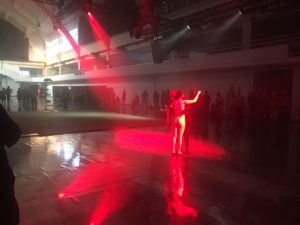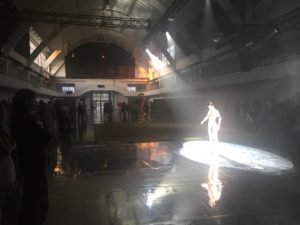The most exciting meeting ground between Jews and Poles today is the POLIN Museum of the History of Polish Jews, which stands in a park in Warsaw’s Muranow quarter. Opened in 2014, its funders included American philanthropists, the City of Warsaw and Poland’s Ministry of Culture. The museum is surrounded by memorials, the most important of which is the 1948 Monument to the Heroes of the Warsaw Ghetto.
On a fine morning in June, I sat on the hip of the Ghetto monument and watched tour groups and crowds of local schoolchildren take advantage of the museum, which allows free entry on Thursdays.
The Warsaw Ghetto Uprising monument was festooned with its usual day-old wreaths and banners named for Israeli Army brigades. Inside the museum, an attentive visitor can find newsreel footage of the monument’s unveiling, amidst pictures of postwar school children carrying Yiddish- and Polish-language banners through the rubble.
This summer’s temporary exhibit at POLIN, Estranged: March ’68 and its Aftermath, is about a less wounding set of events than those of the Second World War, but a black period nonetheless. After the Six Day War, the Soviet-backed Polish government initiated a cynical hunt for “Fifth Columnists” – party members, professors, creative figures and civil servants whose Polish identity was said to run second to their affiliation with Zionism.
Leading up to these events was a series of student protests at universities in big cities like Warsaw and Poznan, which challenged the government’s silencing of any idea or organization that questioned Communist party orthodoxy.
Estranged superbly conveys the trap that Polish Jews fell into during this period. It became impossible to maintain professional lives; state security forces monitored people obsessively, even following families as they journeyed on summer holidays; and then came the punishing terms under which Polish Jews were “allowed” to give up their citizenship, in order to resettle abroad.
This break between the body politic and Polish Jews is relevant today, as the Polish government pursues laws meant to limit discussion, scholarship and commemoration of the Second World War. The goal of such laws, the government insists, is to prevent speech or actions that might cast aspersions on the Polish state’s role in wartime events.
If such laws were to target any negative portrayals of Poland, rather than just its actions during the Holocaust, Estranged would probably be outlawed. It documents state propaganda, institutionalized kangaroo courts and other acts that led to a large exodus of Polish Jews.
The exhibit is careful to name the important publications of the day that resisted the party line. Key intellectuals – Zygmunt Bauman and Leszek Kolakowski among them – were critical and ultimately sacrificed voices, and were ultimately forced to move abroad. The students of such figures – Adam Michnick is the best known – found themselves under arrest and ejected from their university courses. The parents of rebellious students, whether they were military men or scientists, were targeted and accused of having “Jewish tendencies.” How could such children not be inspired by their parents’ views?
The 50th anniversary of the events of 1968 arrives atop another major moment in Polish history: the 100-year anniversary of the inception of an independent Polish state at the end of the First World War. Commemoration of this, especially under the nationalist Law and Justice party, is evident all over the country. Under the title, “Poland Has Risen to Live,” in the courtyard of Warsaw’s Royal Castle, I came across a kind of country hoedown, with girls in peasant skirts and flowers in their hair, and musicians on horns and fiddles leading an eastern European version of a square dance.
READ: A TRIBUTE TO EVERYMAN’S ‘UNCANNY GREATNESS’
In all my years of visiting Warsaw – I first went in 1999 – I’d never stumbled on this sort of thing, and standing on the periphery, I considered my own position in relation to the body politic.
Contrast the scene at the Royal Castle on a mellow June night with the avant-garde spectacle I took in the night before in a gargantuan trade fair hall in central Poznan. There, Maja Kleczewska, one of Poland’s leading young theatre directors, mounted Golem, the final instalment in her Jewish Trilogy. Its first two works were based on S. Ansky’s Dybuk and Jerzy Kosinski’s novel, The Painted Bird.

Kleczewska’s Golem is played by a lithe, young female actor, who remains almost fully naked for the bulk of the show. Like the Golem of Prague, she must be taught human ways – how to speak and perform simple tasks – but she is more android than clay-made creature and, throughout the two-hour performance, her eyes maintain a robotic, focused stare. At one point, her male instructor schools her on how one would greet people in New York (“How do you do?”), as if immigration were an inevitable future challenge.
The Poznan Golem made use of its trade fair set by laying out its action in any number of corners of the building, and by making uses of screens, figures driving mini-cars and plenty of dry ice to give the ever-darkening space an increasingly eerie and corrosive feel. The supporting cast crossed this way and that, often swinging their outstretched arms or racing close enough to the standing viewers to make them jump out of the way.

Influences on the performance were as varied as Ridley Scott’s 1982 masterpiece, Blade Runner, and Yiddish lullabies drawn from prewar Jewish Poland. These were inserted by two elderly actors, one of them Golda Tencer of the Warsaw Yiddish Theater, who haunts the performance, criss-crossing, disappearing and returning like a ghost that will not be silenced.
Footage on an overhanging screen included newsreel images of Germans forced to bury the masses of dead at Bergen-Belsen at the end of the war.
A show like this could be said to flaunt, however indirectly, the recent efforts of Poland’s government to control and limit certain representations of the Holocaust. Polish critics did not miss the possibility that Kleczewska’s Golem meant to insist, provocatively, on the imposition of wartime memory, in response to present-day efforts by the Law and Justice party to winnow memory down to a comfortable form.
The juxtaposition of these things – Polish-language soliloquies, Yiddish song, Blade Runner, Belsen’s mass dead – could not have been more different than the fiddling and square dancing I happened upon in Warsaw.
Contemporary Poland breaks along these lines, as might any country with a history as complex and catastrophic as it has had. A visitor does well to walk into the midst of such juxtapositions, in order to be educated on the present moment, with its echoes of 1968 and the 1940s.






